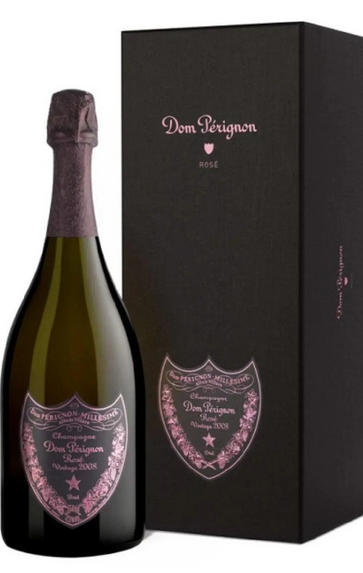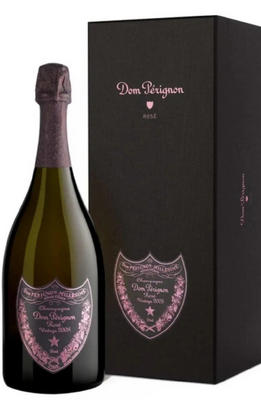
2008 Champagne Dom Pérignon, Rosé, Brut

Critics reviews
The 2008 Dom Pérignon Rosé is magnificent. Rich and deep in the glass, the 2008 offers up an exotic mélange of aromas and flavours. Sweet red cherry, mint, orange peel and rose petal all grace this beguiling beauty. Bright acids and a little less still red Pinot (21%) than in most recent editions yields a Rosé that is delicate and light on its feet, with less of the vinous intensity that marked vintages such as 2006. There is a classic feeling of austerity in the 2018 that is mesmerizing.
Drink 2026 - 2048
Antonio Galloni, Vinous.com (November 2021)
Spring and summer were generally cool and overcast but the year was rescued by a beautiful September, but was it enough? Harvest began on 15 September. Red wines came from Champs de Linotte in Hautvillers (close to the seat of Dom P) and Vauzelles in Aÿ.
First bottle: Pale to mid salmon pink (much deeper than a typical Provence rosé). There's some note that's mineral or iodine or oyster shell on the nose of this. Then we segue into something floral – rose petals? even candied rose petals. This doesn't have quite the substance and undertow of the 2012 and 2003 P2 reviewed alongside. Perhaps it will develop it, but this bottle seems a bit simple. I will open a backup sample to check it out and ensure this is not a cork effect. There doesn't seem to be any TCA on the nose but there is a slight shortage of fruit and no great follow-through on the palate.
Second bottle: This bottle has more fruit on the palate but it still doesn't have real zest and tension. And it rather falls away on the finish. Mind you 2008 was a very grey, cloudy year.
Drink 2022 - 2027
Jancis Robinson MW, JancisRobinson.com (May 2021)
The newly released 2008 Dom Pérignon Rosé is a dramatic, perfumed wine, bursting with aromas of blood orange, iodine, sweet citrus fruit, peach and pear mingled with hints of buttered toast, smoke and spices. Full-bodied, textural and enveloping, with terrific concentration, racy acids and a pillowy mousse, it concludes with a long, penetrating finish. It derives its intense hue from red wine produced from Pinot Noir grown in lieux-dits Chants de Linottes in Hautvillers and Vauzelles in Aÿ.
Drink 2022 - 2042
William Kelley, Wine Advocate (August 2022)
This is a super Champagne with roses, strawberries and orange peel on the nose but then it's medium-bodied with a raciness and beauty.
Drink or hold
James Suckling, JamesSuckling.com (November 2023)
Offering up aromas of white flowers, red berries, toast and fresh pastry, Dom Pérignon rosé 2008 is medium to full-bodied, tense and vibrant, with a vinous texture and sapid nuances. Delicately phenolic, this is a pure and racy gastronomic champagne that’s beginning to drink with style. It concludes with a long and penetrating finish.
Drink 2021 - 2035
Yohan Castaing, Decanter.com (July 2021)
The 2008 Champagne Rosé is another elegant expression, offering notes of cardamom, strawberry, and dried flowers. The palate is dry and well-structured and is balanced and long on the finish, with notes of dried orange peel, redcurrant, and fantastic salinity. It has a great application at the table and should continue to improve over the next 15-20 years.
Drink 2022 - 2042
Audrey Frick, JebDunnuck.com (November 2022)
About this WINE

Dom Perignon
Dom Pérignon was the 17th century Benedictine monk who has gone down in history as the person who "invented" Champagne. His name was originally registered by Eugène Mercier. He sold the brand name to Moët & Chandon, which used it as the name for its prestige cuvée, which was first released in 1937.
A rigorous selection process in both the vineyard and winery ensures that only the best grapes go into Dom Pérignon champagne. Chardonnay and Pinot Noir are used in roughly equal proportions without one variety dominating the other.
In its youth, Dom Pérignon shows incredibly smooth, creamy fruit with perfect balance and weight. As it ages, it takes on wonderfully toasty aromas and a finesse equalled by very few of the other Grandes Marques.
Since 2014 Dom Pérignon has no longer been using the term oenothèque for its late-release Champagnes, but the word Plenitude. This style represents Dom Pérignon champagne that is left in contact with its lees and does not evolve in a linear fashion, but ages in a series of stages, producing “windows of opportunity, or plenitudes” when the Champagne can be disgorged and released to bring consumers a different expression of the same vintage.
There are three plenitudes in the life of a given vintage: the first plenitude spans between seven to eight years after the vintage, which is when Dom Pérignon Vintage is released, while the second one arrives between 12 and 15 years – which was previously the first oenothèque release, but from now will be branded as P2. The third window comes after around 30 years, when the Champagne has spent more than 20 years on its lees, which will now be termed as P3.

Rosé Champagne
Rosé wines are produced by leaving the juice of red grapes to macerate on their skins for a brief time to extract pigments (natural colourings). However, Rosé Champagne is notable in that it is produced by the addition of a small percentage of red wine – usually Pinot Noir from the village of Bouzy – during blending.
Recommended Producers : Billecart Salmon (Elizabeth Salmon Rose), Ruinart

Champagne blend
Which grapes are included in the blend, and their proportion, is one of the key factors determining the style of most Champagnes. Three grapes are used - Pinot Noir, Chardonnay and Pinot Meunier.
26% of vineyards in Champagne are planted with Chardonnay and it performs best on the Côtes des Blancs and on the chalk slopes south of Epernay. It is relatively simple to grow, although it buds early and thus is susceptible to spring frosts. It produces lighter, fresher wines than those from Burgundy and gives finesse, fruit and elegance to the final blend. It is the sole grape in Blancs de Blancs, which are some of the richest long-lived Champagnes produced.
Pinot Noir accounts for nearly 40% of the plantings in Champagne and lies at the heart of most blends - it gives Champagne its body, structure, strength and grip. It is planted across Champagne and particularly so in the southern Aube district.
The final component is Pinot Meunier and this constitutes nearly 35% of the plantings. Its durability and resistance to spring frosts make the Marne Valley, a notorious frost pocket, its natural home. It ripens well in poor years and produces a soft, fruity style of wine that is ideal for blending with the more assertive flavours of Pinot Noir. Producers allege that Pinot Meunier lacks ageing potential, but this does not deter Krug from including around 15% of it in their final blends.


Buying options
Add to wishlist
Description
Spring and summer were generally cool and overcast but the year was rescued by a beautiful September, but was it enough? Harvest began on 15 September. Red wines came from Champs de Linotte in Hautvillers (close to the seat of Dom P) and Vauzelles in Aÿ.
First bottle: Pale to mid salmon pink (much deeper than a typical Provence rosé). There's some note that's mineral or iodine or oyster shell on the nose of this. Then we segue into something floral – rose petals? even candied rose petals. This doesn't have quite the substance and undertow of the 2012 and 2003 P2 reviewed alongside. Perhaps it will develop it, but this bottle seems a bit simple. I will open a backup sample to check it out and ensure this is not a cork effect. There doesn't seem to be any TCA on the nose but there is a slight shortage of fruit and no great follow-through on the palate.
Second bottle: This bottle has more fruit on the palate but it still doesn't have real zest and tension. And it rather falls away on the finish. Mind you 2008 was a very grey, cloudy year.
Drink 2022 - 2027
Jancis Robinson MW, JancisRobinson.com (May 2021)
wine at a glance
Delivery and quality guarantee